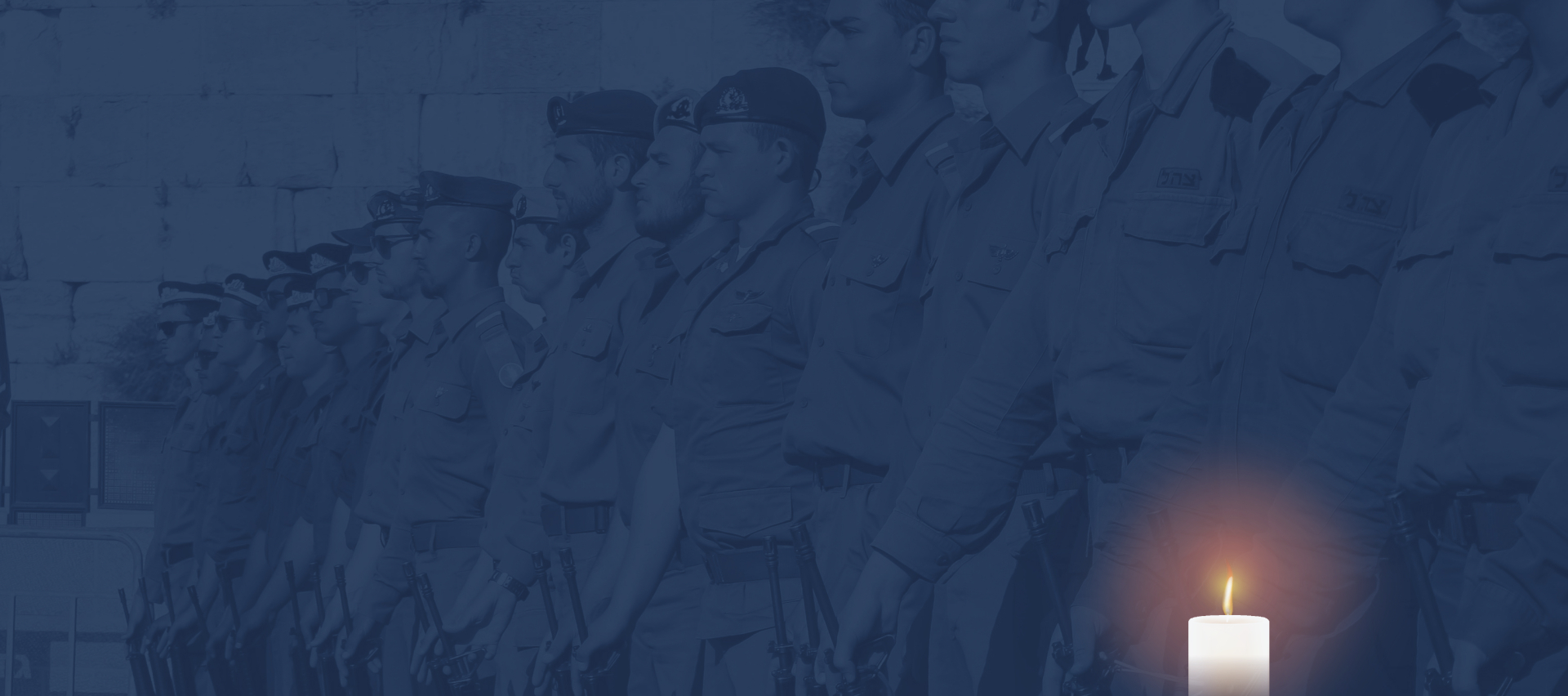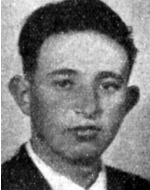,אֵ-ל מָלֵא רַחֲמִים, שׁוכֵן בַּמְּרומִים, הַמְצֵא מְנוּחָה נְכונָה
,עַל כַּנְפֵי הַשְּׁכִינָה בְּמַעֲלות קְדושִׁים, טְהורִים וְגִבּורִים
כְּזֹהַר הָרָקִיעַ מַזְהִירִים, לְנִשְׁמות חַיָּלֵי צְבָא הֲגָנָה לְיִשְׂרָאֵל



Dvorecki, Chaim-Leib
Chaim, the son of Esther-Rachel and Shmuel, was born on 21.7.1927 in Poland, in the town of Ivya, in the Novogrudek district, a city in which 3,000 Jews lived. He studied at the “Tarbut” Hebrew school in his city. His friend from those days testified that he was a clever, industrious, cheerful boy. At first he was a mediocre student, but over time he began to read a lot, persisted and invested until he became the best student in the class. Haim also joined the Hebrew Speaking Association near the school, and soon Hebrew was familiar with him. As a member of the socialist Zionist movement “Dror” he absorbed national values of Israeli culture, and yearned for a pioneering personal fulfillment. With the outbreak of World War II, the entire Novogrudek district was transferred to the Soviets. The schools, including the Tarbut School in Yvye, were closed and only Russian studies were permitted. The Germans occupied the area in 1941, and in July the Nazis reached Iwje. A month later they executed 224 members of the Jewish intelligentsia. In September, a ghetto was established in the city and a Judenrat was declared. Jews from the surrounding towns were brought to the ghetto, the overcrowding increased and the distress of existence was unbearable. Thousands of the city’s Jews were murdered in May 1942, some of them were buried alive. The rest were sent to the Borisov labor camp and murdered there. Only a few managed to escape and join the partisans in the forests. In the summer of 1941, Chaim’s father was murdered by the Nazis. Not long after that, in early 1942, his mother and his only brother were kidnapped before his eyes, and they were slaughtered. Chaim was one of the few who managed to escape to the forests and join the partisans. He was a member of the Farhomenko partisan battalion, one of whose most daring operations was the explosion of the railroad tracks near the Neigorbiala railway station in the autumn of 1943. In the following months, Chaim lived among the partisans, sometimes wandering with hunger but trying to live with the clear goal of avenging the blood of his loved ones. A friend of those days recounted: “What was Simcha after every combat operation?” His face was radiant with enthusiasm about the number of Germans killed. ” During the war Haim joined the Russian Red Army and participated in the battles for the liberation of Europe. When Poland was liberated, Chaim tried to return to normal life in Iwje and began working in the office as assistant bookkeeper. He was very good at his work and soon became an independent bookkeeper, but his only ambition was to immigrate to Israel and live in the homeland. Immediately after the declaration of the end of the war, on May 8, 1945, he left Poland. On the way, walking in the heat and cold progressed slowly. At night he would hide on the roofs of train cars and in the days he would continue walking. Thus he went through a bumpy road and stole over borders until he reached Italy. In Ostia, near Rome, he joined the “Ma’apilim” group of the Ha – Shomer ha – Tsa’ir youth movement, where he stayed until his departure. In the spring of 1946, he prepared to immigrate to Israel on a ship called the “Dov Hoz”, the events of which were known as the “La Spezia affair” – an extensive strike by the immigrants and public activists who joined them in protest against the British intention not to allow them to reach Palestine. The protest succeeded. Dov Hoz, with 675 ghetto survivors from Eastern and Central Europe, members of youth movements and partisans, left for Palestine on May 8, 1946, following the agreement reached with the British. Arriving at the port of Haifa, May 13, 1946, the passengers disembarked and dispersed safely throughout the country. Upon his arrival in Israel, Chaim joined the Haganah and became a member of the “Field Corps.” In Kiryat Haim, where he lived, he worked as a construction worker and after work he immersed himself in evening studies at the Technion in Haifa. It was evident that he felt that the atmosphere of the country might restore some of the happiness he had lost in his life.In late December 1947, a month after the fateful vote at the UNOn the division of the Land of Israel, Chaim was one of the first to enlist. He was placed in Battalion 21 of the “Carmeli” Brigade – the No. 2 Brigade in the Hagana – and served as a translator, a position in which he specialized in World War II. Since then, he has participated in many of the battalion’s activities, including escorting convoys and other operations in Emek Zvulun and the Western Galilee. On the afternoon of March 27, 1948, a large convoy left Nahariya on its way east to Kibbutz Yehiam, which was a Hebrew island in the Western Galilee, in the Lev of a hostile Arab region. The convoy consisted of seven vehicles and 90 fighters, all of them from Battalion 21, including Chaim, and its purpose was to transfer supplies, fortifications and reinforcements to the besieged kibbutz. Near the Kabri junction, the convoy encountered a planned ambush set up by the Arabs – gang members and armed villagers. The battle began at the bend of the narrow road, near the cemetery of Kabri (today the Kabri junction). The first armored vehicle managed to break into the kibbutz, but the rest of the vehicles were ambushed. The convoy members fought until the evening, and only under cover of darkness did some of them escape, but about half of them, 47 Carmeli fighters, fell in battle. Haim was among those killed in the battle. He was twenty-one years old when he fell. He was laid to rest in a mass grave in the Nahariya military cemetery. His friend from childhood eulogized him: “Haim, your name indicates that you loved life, love and for their sake also fighting, fighting and falling hero … In our hearts you continue to live, you are between life and creators … love and devotion to the homeland. From your youth, your work was not for your precious teachers … You were educated in sons to be proud of our people … You were Simcha and proud that you won this great position, to be a fighter for the establishment of our state, and you did not win the great day of the declaration of the state. You did not get to see the liberated Yehiam, for whom you fought and fell, our consolation: the death of your parents and your brother was your death. , Your homeland. ” Chaim’s partisan activity is mentioned in Shalom Cholawski’s book “Mary and Partisan Warfare.” His name is engraved on the monument to the 69 fallen soldiers in the Yehiam Convoy, located at the memorial site south of the Kabri junction. The site reconstructs the site of the battle, as well as a memorial wall with a relief of the map of the area’s settlements and the location of the convoy on the day of the battle. This hero is a “last scion”. The survivors of the Holocaust are survivors of the Holocaust who survived the last remnant of their nuclear family (parents, brothers, sisters, sons and daughters) who experienced the Holocaust in the ghettos and / or concentration camps and / or in hiding and hiding in territories occupied by the Nazis and / Or in combat alongside members of the underground movements or partisans in the Nazi-occupied territories who immigrated to Israel during or after World War II, wore uniforms and fell in the Israeli army.

